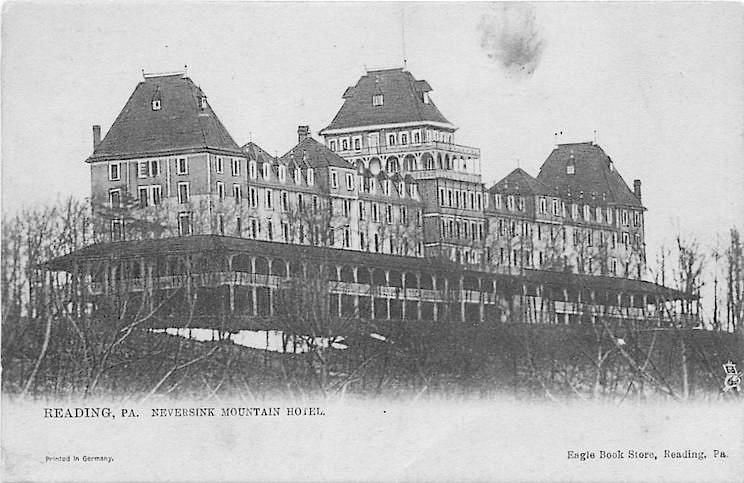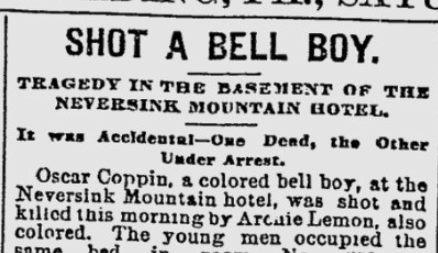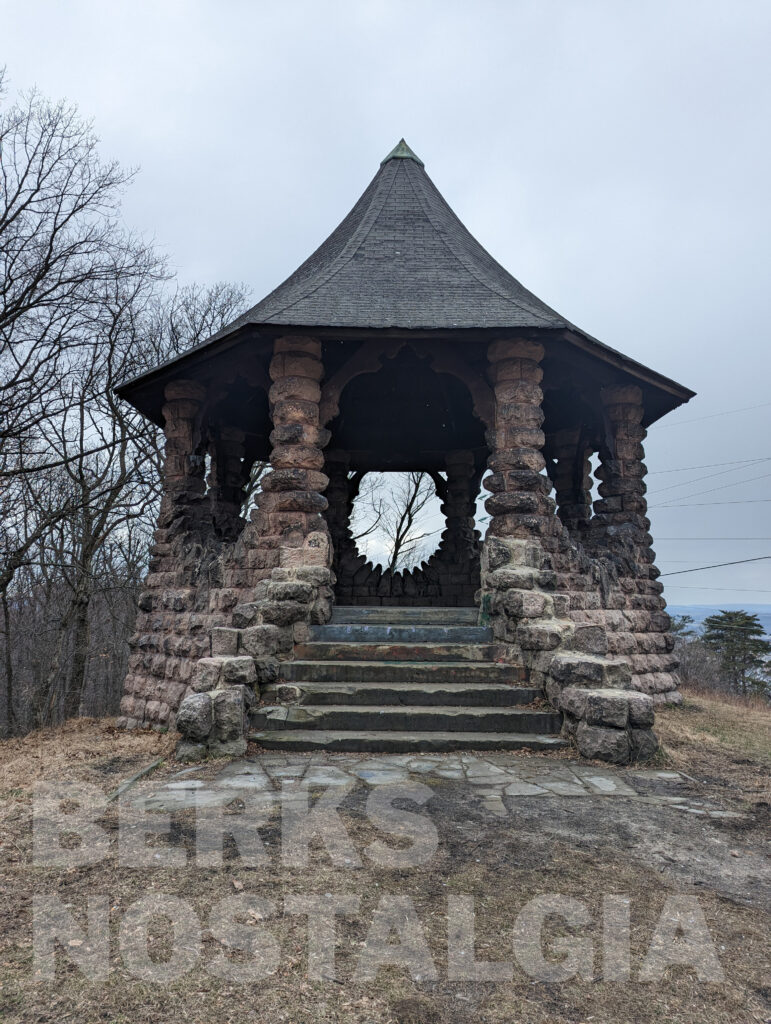Like Mt. Penn, Neversink had its own railroad loop that started at South 9th street and wrapped all the way around the mountain to Klapperthal Junction. The other resorts on Neversink mountain were Centennial Springs Hotel, Glen Hotel, and the Highland house; which famously had the vertical rail known as “Ganser’s Incline” going from 13th Street straight up the mountain. An amusing side note; according to an April 4th, 1922 Reading Times article, the inclined railway inspired such fear in the passengers who road it that it was only in operation exclusively from 1889-1902 and then intermittently until 1907 when it was completely abandoned.
The only remains of the once grand Neversink Mountain Hotel is the pavilion that has been affectionately deemed “The Witch’s Hat” by locals due to its appearance, but was actually formally named the “West End Pavilion”.
Plans for the construction of the hotel were announced in the January 18th, 1892 Reading Times. It was a conglomeration of many prominent business men in the Reading area. Among some the stockholders in this venture were the likes of; George F. Baer, Peter Barbey, Henry Muhlenberg, Morton McIlvain and the Klapperthal Land Company.

Construction on the Neversink Mountain Hotel began in March of 1892. It sat just to the east of the pavilion. It was 360 feet in length and 45 feet in width, five stories tall and boasted 168 rooms. Other amenities included a grand assembly hall, dining room, barber shop, billiard room and a bar. The grounds covered 15 acres and included walking paths, tennis courts, croquet and a children’s playground. By the time the place was constructed and furnished it cost $160,000.
There was some controversy around the naming of the hotel. Apparently a lot of locals were unhappy with the name “Neversink”; wanting something more attractive and romantic sounding. In March 1892 the Reading Times ran opinion articles from residents who thought the hotel should be called the “Wenonah Inn”.

The Hotel opened on July 7th, and from conception to completion took only 5 months. It was a seasonal resort, only open between June and September.
There was at least one death that occurred at the Neversink Mountain Hotel. On July 8th, 1893 two bell boys who were housed in a basement room of the hotel were fooling around when a gun they were reaching for went off. Archie Lemon touched the gun as it discharged and hit Oscar Coppin above the eye, killing him. Coppin was 17, and Lemon 19. Four other boys also witnessed what was deemed to be an accident.

Neversink Mountain Hotel lasted only thirteen seasons, when it was completely destroyed by a fire on September 29th, 1905. The season had ended on Labor Day, and the only occupants were a night watchman and a housekeeper. The fire started from three places in the basement, the center and at both the east and west ends. Quite obviously the work of arsonists, it was said that three figures were seen leaving the premises shortly after the fire began.
No fire department serviced the mountain. The blaze was such a spectacle to the city residents that the United Traction Company got out its Neversink Mountain railway cars and ran them up and down the mountain full of spectators to go watch it burn all night. The subheadline in the next day’s Times read:
“Losing Venture Ends; Flames complete history of thirteen seasons of financial frost for citizens of Berks County who invested $160,000 in enterprise unfortunate from the start.”
The article went on to expose that the hotel never actually made money. It blamed the isolated location along with short seasonal period for the lack of profit. One example of this was that in September 1894, only two years after opening, the dining hall waiters went on strike due to their wages going unpaid. This actually forced the hotel to close prematurely for that season. It is also worth mentioning that many had the impression from hotel management that locals were not welcomed to patronize the hotel, as they exclusively desired guests from nearby large cities such as Philadelphia and New York. I was not able to find any hard documentation of that from local newspapers, but the prospect is not shocking.
At the time of the fire the building was only insured for $31,500; about a quarter of what it would cost to rebuild and refurnish. Oddly enough, 24 hours before the fire started, the property was sold to a Rev. Father Bornemann, pastor of the St. Paul Catholic Church. He purchased the hotel and land for $20,000, and since he was technically the owner when it burned, the insurance payout was adjusted. He ended up getting $11,500 of the policy’s payout on the property.

Nothing ever ended up being built in its place. The property is now a part of the Neversink Mountain Preserve. The West End pavilion was built along with the hotel in 1892, and was dedicated to the memory of a William McIlvain, whose last name you might recognize, as he was the father of one of the original stockholders of the hotel. Apparently, he enjoyed visiting this spot for the view. He died in 1890 and is buried in Charles Evans near an exact replica of this pavilion; the only other in the county.
The Witch’s Hat is one remnant of the victorian era in Berks County on Neversink. One of luxury and excess, and many failed endeavors ending in arson and secrets.
This makes Monsignor Bornemann look a bit like a mafioso. The article doesn’t mention the origin of the fire.
Because the origins of the fire were never determined, at least publicly